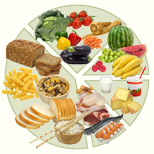Organising and planning
Eating and drinking takes up a lot of time in a child’s day within a children’s service like Cybertots. It can be a favourite part of the day for some. But who organises it and how do they do it?
Nola is the food co-ordinator at Cybertots and she has lots of responsibilities, mostly organising and planning the food and drinks for all the children at the centre. That’s a lot of shopping, cooking, storing, chopping and stirring! Many of the decisions she makes are in conjunction with other staff and of course parents, and reflect her knowledge of nutrition and child development.
When Nola plans the food and drinks she also has rules and regulations to follow. Some of the rules and regulations she needs to follow are:
- The National Food Safety Guidelines
- Australian Dietary guidelines
- Infant Feeding Guidelines
- Dietary Guidelines for children and adolescents.
Do some research on the internet or at the library into the four sets of guidelines listed above. Write a half page summary of each in your notebook.
But what else does Nola need to consider?

Well, first of all she needs to make sure that all children are provided with food and drinks that are consistent with all the relevant guidelines that we have mentioned. This means she has to be very familiar with them and make sure that each day and each weekly menu meets all the criteria. Nola checks that the children have the appropriate amount of the following five food groups.
- Bread, cereals, rice, pasta, noodles.
- Vegetables and legumes.
- Fruit
- Milk, yoghurt, cheese.
- Lean meat, fish, poultry, eggs, nuts.
Research the five food groups and find out what the main distinguishing nutrients are in each one.
- Write down everything you ate yesterday.
- Did you eat something from every food group?
- Did you eat mostly fresh and unprocessed food?
Write your answers in your notebook.

It is not actually enough just to eat from every food group, it is important to eat the right amount of each group too. A balanced diet is the healthiest.
Click on the image to see what a balanced diet looks like.
A balanced diet will mean that you are receiving all the nutrition you need - enough carbohydrates, iron, energy, protein, fat, fibre magnesium, water, zinc, thiamin, riboflavin, niacin, folate, sodium, vitamin C, potassium, calcium, vitamin A and vitamin B12.
That's a lot to remember! It's simple to include all these in your diet if you eat a balanced diet.
Find out why we need the following and what foods we can find them in:
protein, carbohydrates, fat, vitamins, minerals and water
Write your findings in your notebook.




